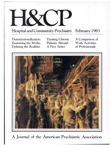A Comparison of Work Activities of Mental Health Professionals Among Disciplines and Environments
Abstract
Due to fiscal constraints on health care providers, the utilization of time of mental health professionals has come under close examination. The authors conducted a study of the work habits of 193 psychiatrists, psychologists, nurses, rehabilitation therapists, social workers, and mental health workers in 1976 and 1977. The clinicians worked at 18 facilities that offered inpatient, outpatient, partial hospital, or a mix of partial and outpatient services. Their work activities were observed over a two-week period. The data were analyzed for each clinical type and for each service modality across three funding sources—state, private, and mixed. The data, in part, show that a substantial amount of time was spent in all types of facilities in indirect patient care activities, particularly use of psychiatric records. Privately funded inpatient facilities devoted a much greater amount of time to direct patient care than did state inpatient facilities, which spent more time on administration and use of records. Staff of outpatient or partial-mixed facilities spent much more time on individual or other therapies, while inpatient staff spent more time on patient management and informal contacts with patients.
Access content
To read the fulltext, please use one of the options below to sign in or purchase access.- Personal login
- Institutional Login
- Sign in via OpenAthens
- Register for access
-
Please login/register if you wish to pair your device and check access availability.
Not a subscriber?
PsychiatryOnline subscription options offer access to the DSM-5 library, books, journals, CME, and patient resources. This all-in-one virtual library provides psychiatrists and mental health professionals with key resources for diagnosis, treatment, research, and professional development.
Need more help? PsychiatryOnline Customer Service may be reached by emailing [email protected] or by calling 800-368-5777 (in the U.S.) or 703-907-7322 (outside the U.S.).



